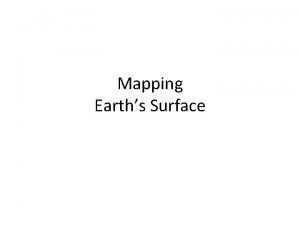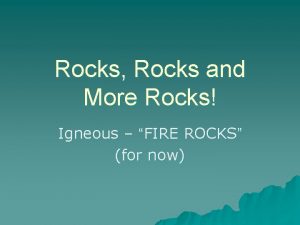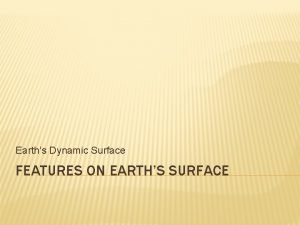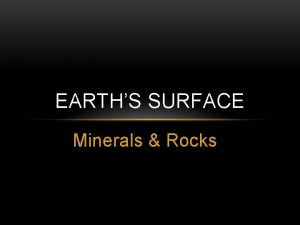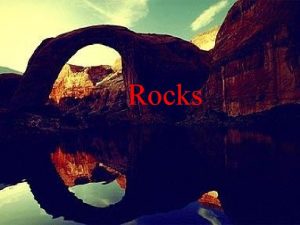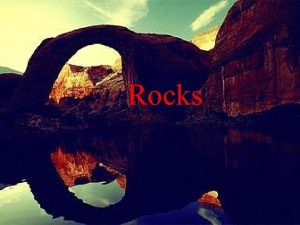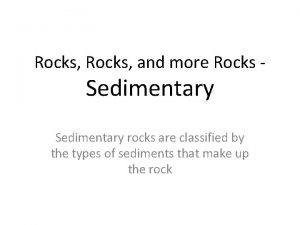The Earths Surface AKA Rocks and More Rocks

















- Slides: 17

The Earth’s Surface AKA Rocks, and More Rocks

What is a Rock?

What is a Rock? • A rock is a naturally formed solid that is usually made up of one or more types of minerals • A mineral is a substance that: – Forms in nature – Is a solid – Has a definite chemical makeup – Has a crystal structure

True or False? • Rocks are solid, and therefore, never change False! Rocks do change, but the changes usually occur over a huge span of time – thousands to millions of years!

Rock Cycle • The rock cycle is a set of natural processes that form, change, break down, and re-form rocks • Rocks do not need to move through the rock cycle in any particular order • At any point in the cycle, rocks can change in two or three different ways

Rock Cycle • Notice how each rock can change in at least two different ways


Three Types of Rocks • Igneous Rock – Forms when molten (hot liquid) rock cools and becomes solid – Can form within Earth or on the Earth’s surface – Example: granite

Two Types of Igneous Rock • Intrusive Igneous Rock – forms when magma cools within the Earth • Extrusive Igneous Rock – forms when lava cools on the Earth’s surface

Igneous Rocks • Form long lasting landforms because they are harder than other types of rock • Mineral size in igneous rock is determined by the cooling rate of the magma

Three Types of Rocks • Sedimentary Rock – Forms when pieces of older rocks, plants, and other loose materials get pressed or cemented together – Usually contains visible layers – Examples: shale, limestone

Sedimentary Rocks • Rocks can form from plants or shells – Coal – formed millions of years ago from dead plants; many fossils are found in coal – Limestone – formed from shells and skeletons of ocean organisms; these settle to the ocean floor, are buried, and become cemented together as limestone

Sedimentary Rocks • Sediment – material that settles out of water or air • Can be made from small or large particles – Small particles – formed by pressure alone – Large particles – minerals form; act as cement

Three Types of Rocks • Metamorphic Rock – Forms when heat or pressure causes older rocks to change in structure, texture, or mineral composition – Example: marble

Metamorphic Rock • Change from pressure and temperature – Pressure causes rocks to flatten – If the rock melts, it becomes an igneous rock Sedimentary Metamorphic Sandstone Quartzite Metamorphic Igneous Gneiss Dacite

Metamorphic Rock • Recrystallization – heat and pressure break apart minerals; minerals then form new chemical bonds – Crystals can then grow larger – New minerals can form in place of the old ones

Metamorphic Rock • Can be separated into two categories: – Foliated Rock – develop when rocks are under pressure; foliation – the arrangement of minerals in flat or wavy parallel bands – Non-foliated Rock – rocks are not exposed to high pressure; example: marble – used by sculptors because it doesn’t split into layers
 More more more i want more more more more we praise you
More more more i want more more more more we praise you More more more i want more more more more we praise you
More more more i want more more more more we praise you Igneous rock to metamorphic rock
Igneous rock to metamorphic rock Compaction and cementation
Compaction and cementation Extrusive rocks and intrusive rocks
Extrusive rocks and intrusive rocks Andesite vs basalt
Andesite vs basalt The earth's layers foldable
The earth's layers foldable Earths roation
Earths roation Whats earths moon called
Whats earths moon called Forest desert tundra grassland
Forest desert tundra grassland What is the most abundant element on earth
What is the most abundant element on earth How thick is the earths crust
How thick is the earths crust Whats earths moon called
Whats earths moon called Thickest layer of the earth
Thickest layer of the earth Earths early atmosphere contained
Earths early atmosphere contained The earths layers foldable
The earths layers foldable Earths major crustal plates
Earths major crustal plates Earths orbit seasons
Earths orbit seasons


















